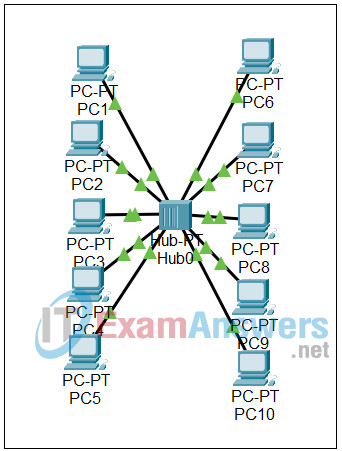9.4.2 Packet Tracer – Observing the Effects of Collisions in a Shared Media Environment Answers
Topology

Learning Objectives
- Setup and run the simulation
- Examine the results
Introduction:
In early implementations of Ethernet, hosts were directly connected to a shared coaxial cable in a bus topology. The method used to control access in this shared media environment was Carrier Sense Multiple Access with Collision Detection (CSMA/CD). In later implementations, hubs replaced coaxial cable, but collisions were still part of the basic operation. In this activity, we will examine a network with 10 PCs connected to a hub, and observe the operation, while they try to communicate simultaneously.
Task 1: Setup and run the simulation
Step 1. Enter simulation mode
Click the Simulation tab to enter simulation mode. The two envelopes on each of the PCs on the left side of the hub represent an ICMP echo request intended for the corresponding PC on the right side of the hub and an ARP request to learn the MAC address of the target PC. We will attempt to send these packets simultaneously through the hub.
Step 2. Run the simulation
Click the Auto Capture / Play button. All five ARP requests collide at the hub and a damaged frame is broadcast to all of the PCs. The events are added to the Event List. Continue clicking the Auto Capture / Play button. An ICMP event is added to the Event List as each of the five PCs on the left time out the ARP request, and drop the buffered packet. A dialog box appears indicating there are no more events. Click OK to close it.
Task 2: Examine the results
Step 1. Access specific PDUs
In the Simulation Panel Event List section, the last column contains a colored box that provides access to detailed information about an event. Click the colored box in the last column for the first event at Hub0. The PDU Information window opens.
Step 2. Examine the contents of the PDU Information Window
The first event at Hub0 describes the operation of a hub and the collision that occurred. Examine the PDU information for the remaining events in the same fashion and note the effects of the collision.
Step 3. Examine other scenarios
Select Scenario 1 at the bottom center of the interface. We will try to send just two packets simultaneously through the hub. Run the simulation as described above and observe the results. This scenario also fails. Select Scenario 2 at the bottom center of the interface. Run the simulation as described above and observe the results. The MAC address is resolved, the ICMP echo request is sent, and the ICMP echo reply, is received only when one PC sends information at a time.
